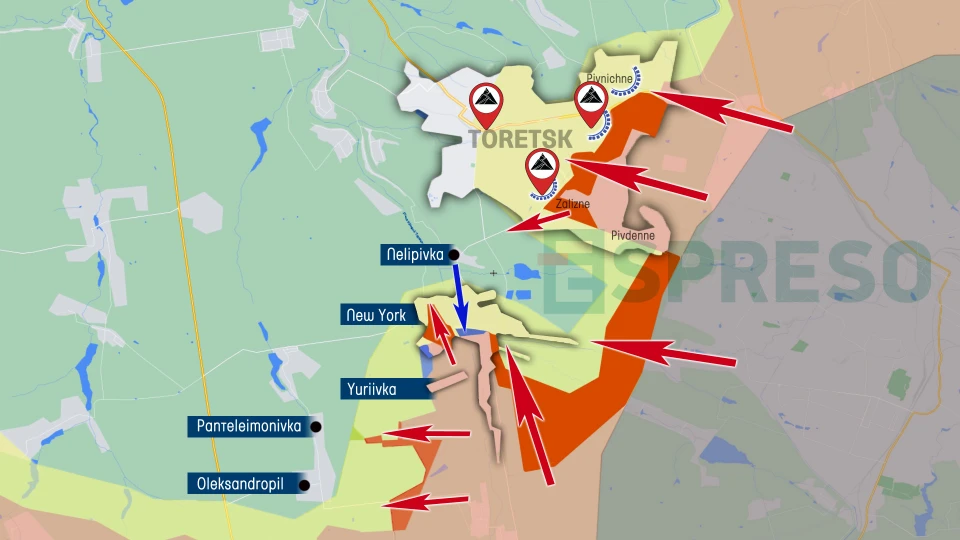
August 1-7 live war map: Russia breaks through Pokrovsk's first defense line, surrounds New York. Ukraine opens front near Kursk
Russian forces are intensifying their assault on Pokrovsk, marking a significant escalation with over 300 battles reported in just one week. The situation is tough for the Ukrainian troops in Toretsk. However, elsewhere, Ukraine's Defense Forces have not only held the line but also breached the Russian border in the Kursk region
Chasiv Yar’s seesaw
Russian forces are obliterating the town with guided bombs and seeking gaps in Ukraine's defense to establish a foothold on the right bank of the Siverskyi Donets canal. They attack in small groups of up to 10 soldiers, who cross the canal without armored vehicles in places where it goes underground, making it possible to cross on a scooter. Last week, they managed to cross the canal near the village of Kalynivka but failed to secure a position there – Ukrainian defenders destroyed them all. This week, the Russian army achieved some success, advancing towards the Zhovtneviy district along route 00506. Battles are ongoing to prevent Russian forces from expanding their foothold. Russian troops trying to entrench themselves in residential areas are being targeted, along with the surrounding buildings, resulting in a scorched landscape that will complicate cover for future assault waves. The situation in the town is dynamically developing and constantly changing.
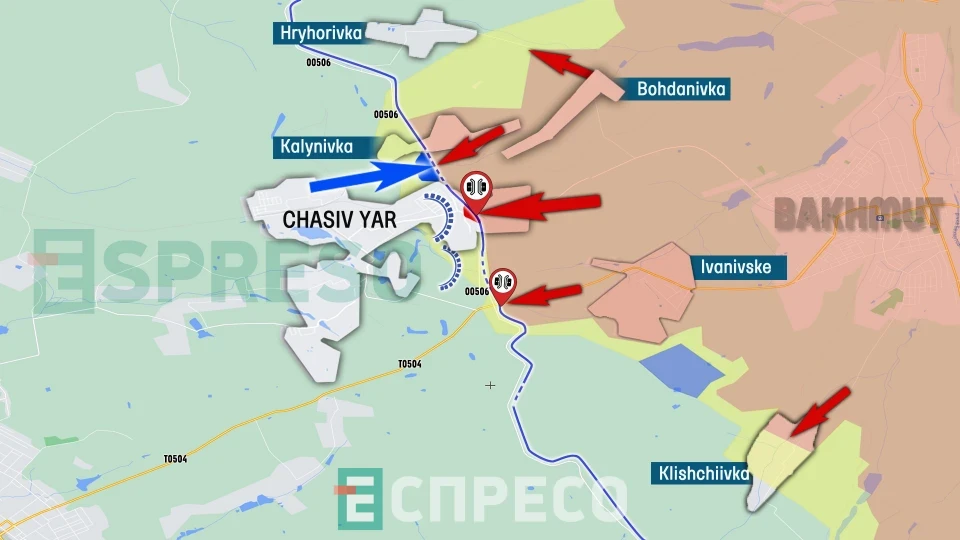
Encirclement of New York and capture of Toretsk's outskirts
Despite the Ukrainian Armed Forces pushing back the invading Russian troops from a certain area in the central district of New York, Russian troops have established themselves in a small area on the other side of the Kryvyi Torets River and are constantly attempting to advance by assaulting the village center. At the same time, they are expanding their flanks primarily to the east to connect with units fighting south of Toretsk. Here, the Ukrainian troops managed to withdraw from their positions, avoiding encirclement between the two advancing Russian armies. Additionally, Ukrainian fighters are still holding the eastern outskirts of New York.
The western flank of the Russian army is breaking through the village, bypassing the central part. Recently, they managed to advance 600 meters north from the TNK gas station and capture school No.38, nearly reaching the northwestern outskirts of the village. Continuing in this manner, they could start encircling Niu York within a few days.
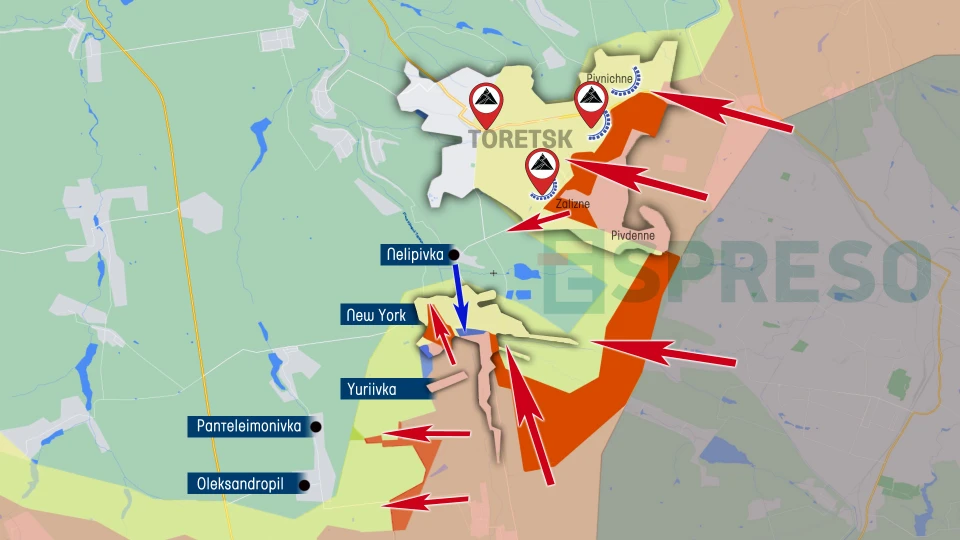
Russian forces are also advancing westward toward Ukraine's fortified area near Panteleimonivka and Oleksandropil. On the outskirts of Toretsk, they have almost completely occupied the village of Pivdenne, about half of the villages of Pivnichne and Zalizne, and are also trying to enter Toretsk itself, though so far without success. The Russian advance from Zalizne toward the village of Nelipivka, which covers Niu York from the north and protects it from encirclement, looks threatening. With each week, the advance on Nelipivka becomes stronger, which could threaten Niu York with complete encirclement. Currently, to connect the two points of their attack, Russian troops need to break through another 4.5 km of Ukraine’s defenses. However, the defenders of Niu York are already under crossfire.
The battle for Toretsk could become the main objective of the Russian Armed Forces in the second half of this year. Currently, they are trying to cross the railway line along Central Street and wedge themselves between the Artem and Pivnichna mines' spoil heaps, which are the main defensive strongholds on the first line of defense. Unfortunately, Russia has managed to achieve this goal in two places, and now battles are ongoing to prevent Russian forces from developing this success. The invading forces, in turn, are assaulting the Ukrainian defenders of both spoil heaps.
Pokrovsk prepares a series of new defensive lines
The Russian army has significantly increased its forces in the Pokrovsk direction. We all hoped that the Ukrainian Defense Forces would manage to hold back the Russian advance by establishing a defensive line along the Vovcha River. However, the invading Russian forces broke through the defenses near Prohres and continued their advance along the ridge between the valleys of the Vovcha and Kazennyi Torets rivers. Over ten days, they penetrated 8 km deep and flanked Ukrainian defenders.
Following this breakthrough, Russian troops have focused on expanding their wedge and pushing out the Ukrainian Armed Forces, who were still holding the left bank of the Vovcha in the area between Novoselivka Persha and Yasnobrodivka. As they advance deeper into Ukrainian positions toward Zhelanne and Komyshivka, it becomes increasingly dangerous for Ukrainian soldiers to maintain the bridgehead near the Vovcha due to the significant risk of encirclement. Therefore, the Ukrainian Defense Forces will likely soon withdraw from the already fully occupied Yasnobrodivka and concentrate on defending Komyshivka and Novozhelanne.
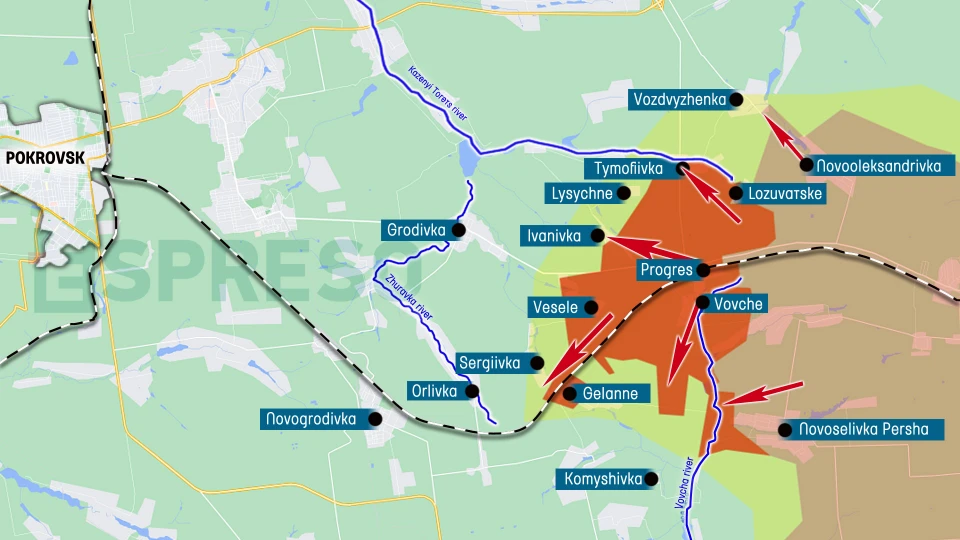
In the near future, it is also likely that Russian forces will capture Zhelanne, surrounded on three sides, and focus on further advancing along the railway toward Novohrodivka, where the Ukrainian troops are constructing a new defensive line. This line will also run along the Zhuravka River, through the villages of Hrodivka and Vozdvyzhenka, and along the Kazennyi Torets River. Meanwhile, Russian troops, having occupied Vesele and Tymofiivka within a week, continue moving toward this defensive line. They are assaulting the villages of Lysychne and Ivanivka and intend to capture the entire area between Kazennyi Torets and Zhuravka to be able to ford these rivers at several points. This would increase pressure on Ukrainian soldiers, who have been holding back Russian forces near Vozdvyzhenka for a month. Facing such resistance, Russian troops will likely use their usual tactics of flanking attacks and bypassing defensive redoubts.
On the southern flank of this front, the invading Russian forces have been unable to break through Ukraine’’s defenses near Karlivka, so they are also searching for bypass routes. They have already intensified attacks on the village of Nevelske and are fording the Lozova River to complete the occupation of Krasnohorivka and launch an offensive on Karlivka from the south.
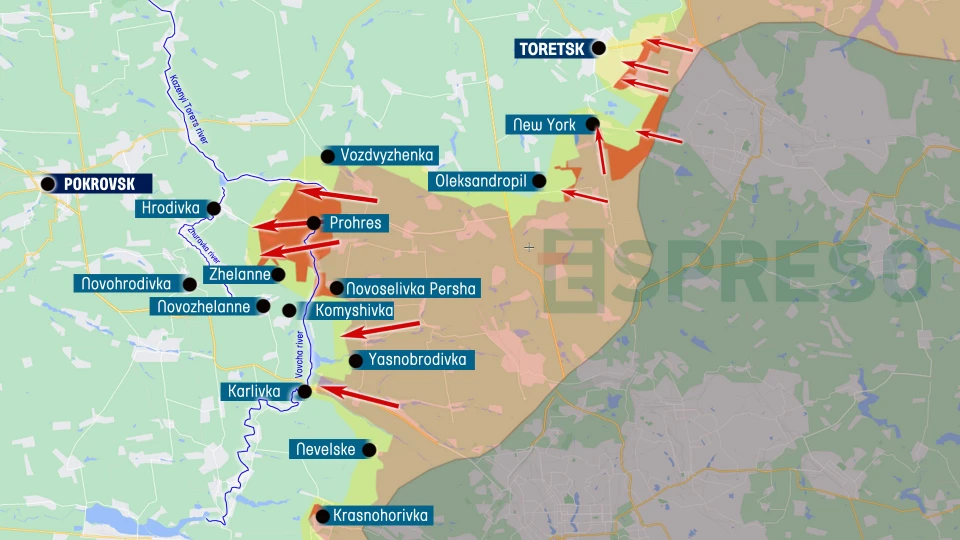
Kurakhove and Vuhledar – Russian troops have reached the highway
In this direction, there have been few territorial changes, but those that have occurred are significant. Russian forces managed to advance south of Kostiantynivka and engage in battles to reach the highway leading from this village to Vuhledar, one of the city's logistical arteries. The highway is not yet cut off, but the invading Russian forces are very close to doing so. This success could also threaten the occupation of Kostiantynivka itself, which would be squeezed between two Russian armies advancing along Highway 00532 from both the south and the north. Russian forces have intensified their offensive near the village of Pobieda, which they occupied a few months ago.
South of the road to the village of Vodiane, near Mykilske, Russia has advanced a kilometer toward Vuhledar, reducing the distance to the highway to 3 km. Previously, they had made progress along the road to Vodiane itself, reducing the distance to the intersection to 2 km. In this way, they are trying to cut off the Kostiantynivka-Vuhledar highway at three points, making slow progress everywhere.
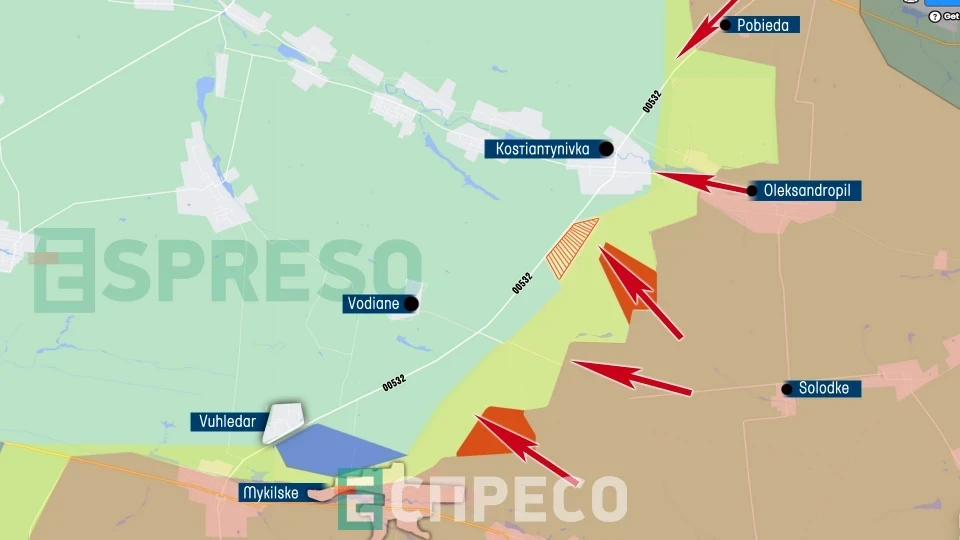
In the Kurakhove direction itself, the Ukrainian Defense Forces have long managed to hold back Russia near the one-third occupied Heorhiivka. It is expected that after occupying Krasnohorivka, the Russian Armed Forces will redeploy part of their forces to advance on Kurakhove.
Russia is burning, Ukraine's Armed Forces break through the border
The Ukrainian Armed Forces are currently striking Russian infrastructure more than Russia is hitting Ukraine. In temporarily occupied Crimea, the Ukrainian troops nearly destroyed two out of five airfields. This week, they targeted Morozovsk in the Rostov region, delivering a powerful missile strike that effectively destroyed it. Several fighter jets were either burned or damaged, along with all ammunition and fuel depots. Since then, strikes with guided bombs – Russia’s most formidable weapon – have significantly decreased. Another Rostov-na-Donu submarine, based in Sevastopol, was sunk by two ATACMS strikes. Additionally, missiles destroyed all S-400 air defense launchers near the village of Flotske. In occupied Luhansk, missiles destroyed part of the Donets plant, which Russia had converted into a base, with over 10 explosions heard in the city.
Ukrainian drones attacked Russia's largest oil refinery in Omsk, 2400 km from Ukraine, burning 600,000 tons of oil and requiring 3-4 months of repairs. Moreover, an explosion caused a fire at the refinery in Ukhta, in the Komi Republic. A blast in Volgograd destroyed a substation, cutting off power, while an oil depot burned in Azov, Rostov region.
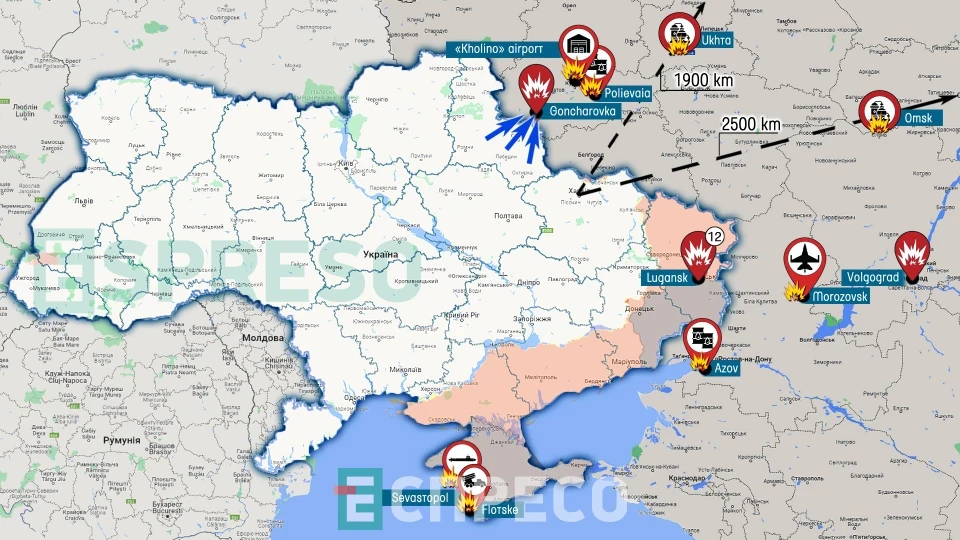
In Kursk, the Ukrainian Armed Forces destroyed two weapon and equipment storage depots near the Khalino airfield and an oil depot in the village of Polevaya near Kursk. These strikes were likely preparatory. On August 6, the Ukrainian army crossed the Russian border with three armored columns and began moving toward Kursk, 80 km away. In the first half of the day, Ukrainian forces advanced over 10 km, attacking the town of Goncharovka and the district center of Sudzha, capturing or entering 11 border villages. Meeting no resistance, they destroyed FSB detachments and army units, took prisoners, and demonstrated Russia's vulnerability. The situation is developing as Russia is pulling reinforcements from the Bryansk and Belgorod regions. Meanwhile, parts of the 82nd Airborne Brigade, along with other special units in their Strykers, are advancing deeper into Russia. Interestingly, it is only 70 km from Sudzha to Kurchatov, where a nuclear power plant is located. Russia has already declared a nuclear explosion threat due to shelling in Kurchatov. Although this information is likely intended to scare the West, the threat to Kurchatov or Kursk, which is also poorly defended, could significantly improve Ukraine's negotiating position, especially in light of the Russian advance in Donetsk.
Maps are based on information received from the Ukrainian Armed Forces' General Staff, as well as other open and verified sources. However, the maps are not highly accurate and only conditionally reflect trends in the combat zone.
- News





